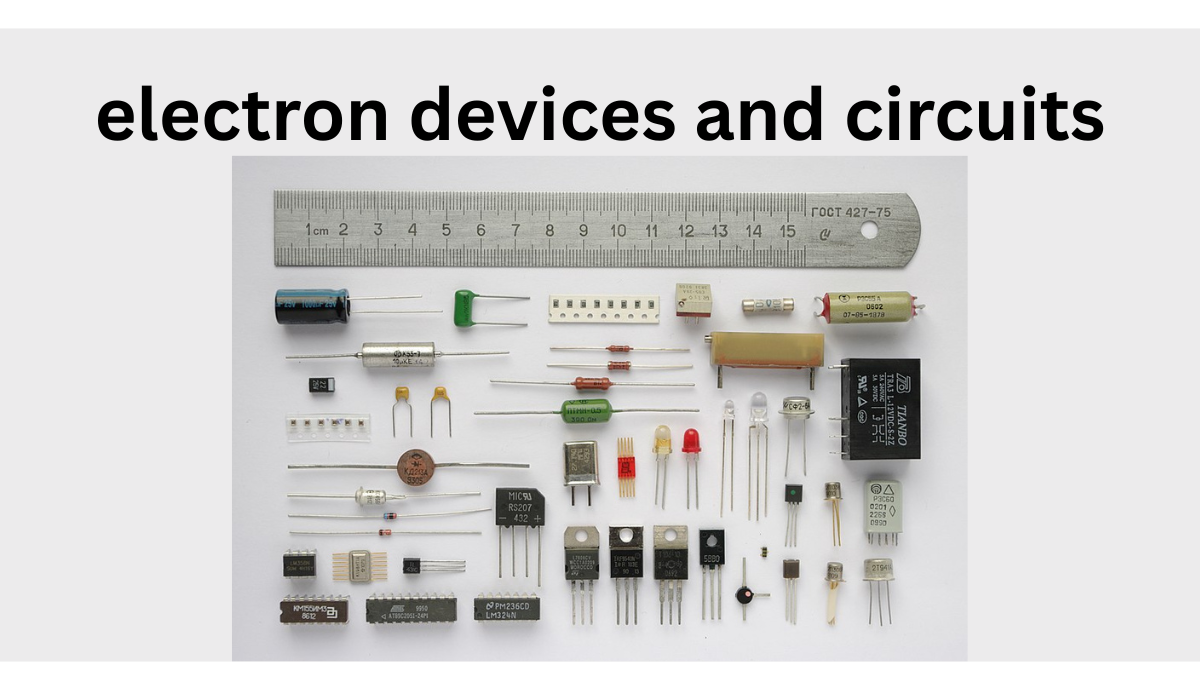In the heart of every smartphone, every computer, every medical device, and every car dashboard lies a complex web of tiny components working in harmony to make our modern lives possible. These components—transistors, diodes, capacitors, and resistors—are part of a fascinating field known as electron devices and circuits.
From the moment you switch on a light to the streaming of a live concert across continents, electron devices and circuits are at play behind the scenes. This article takes you on a comprehensive journey through the world of electron devices and circuits—what they are, how they work, where they are used, and why they are central to technology as we know it.
We’ll explore the theory, applications, history, and future of this essential domain of electronics, all in a user-friendly and human tone that doesn’t require a PhD in engineering to understand.
1. What Are Electron Devices and Circuits?
Let’s break it down:
-
Electron devices refer to physical components that manipulate the flow of electric current (electrons) in a controlled way. Examples include:
-
Diodes
-
Transistors
-
Vacuum tubes (historically)
-
Photodiodes
-
Light-emitting diodes (LEDs)
-
-
Circuits are networks formed by connecting these devices (along with passive components like resistors and capacitors) to perform a specific function like amplification, switching, or signal processing.
Together, electron devices and circuits form the building blocks of everything from radios to supercomputers.
2. A Brief History: From Vacuum Tubes to Silicon Chips
The history of electronics began in the early 20th century with vacuum tubes, which were used for signal amplification and switching in radios and early computers. But they were bulky, power-hungry, and prone to failure.
Then came a revolution: the invention of the transistor in 1947 at Bell Labs by John Bardeen, William Shockley, and Walter Brattain. Smaller, more reliable, and energy-efficient than vacuum tubes, transistors paved the way for the integrated circuit (IC) in the 1950s and microprocessors in the 1970s.
This shift from analog vacuum tubes to digital silicon devices changed everything—leading to the computers, smartphones, and IoT devices we use today.
3. Key Electron Devices and Their Functions
Let’s explore the most commonly used electron devices and how they work:
1. Diodes
A diode allows current to flow in one direction only. It’s the electronic equivalent of a one-way street.
-
Used in: Rectifiers (AC to DC conversion), protection circuits, signal demodulation.
2. Light Emitting Diodes (LEDs)
A type of diode that emits light when current passes through. LEDs are energy-efficient and long-lasting.
-
Used in: Displays, lighting, indicators, optical communication.
3. Transistors
Perhaps the most important invention of the 20th century, transistors act as electronic switches or amplifiers. There are two main types:
-
Bipolar Junction Transistors (BJT)
-
Field Effect Transistors (FET)
-
Used in: Computers, amplifiers, signal processors, smartphones.
4. Photodiodes and Solar Cells
These devices convert light into electricity, harnessing the photoelectric effect.
-
Used in: Solar panels, sensors, optical communication.
5. Thyristors and Triacs
These are used for controlling large power flows in devices like industrial motors and light dimmers.
-
Used in: Power control applications, AC switches.
4. Understanding Basic Electronic Circuits
An electronic circuit is like a recipe—it combines different devices in a certain way to achieve a desired outcome. Here are a few basic types:
1. Rectifier Circuits
Convert AC (alternating current) into DC (direct current) using diodes.
2. Amplifier Circuits
Increase the strength of a weak signal using transistors or op-amps.
3. Oscillator Circuits
Generate repeating signals like sine waves or clock pulses.
4. Filter Circuits
Remove unwanted noise or signals from electronic inputs using capacitors and inductors.
5. Logic Circuits
Perform digital logic operations (AND, OR, NOT) using transistors in specific configurations.
Each of these circuit types is found in everyday devices, working invisibly but critically to keep our gadgets functioning.
5. Analog vs. Digital Circuits
Electronic circuits are generally classified into two types:
Analog Circuits
-
Work with continuous signals.
-
Used in audio amplifiers, radios, and sensors.
-
Sensitive to noise and signal degradation.
Digital Circuits
-
Work with binary signals (0s and 1s).
-
Found in computers, smartphones, and digital cameras.
-
Highly reliable and scalable.
Today’s electronics often integrate both analog and digital circuits, known as mixed-signal systems.
6. Real-World Applications of Electron Devices and Circuits
The impact of electron devices and circuits is felt across almost every sector. Here’s how they shape the world around us:
1. Consumer Electronics
-
Phones, TVs, gaming consoles, home assistants—all rely on integrated circuits made of transistors, diodes, and capacitors.
2. Medical Devices
-
Pacemakers, MRI machines, hearing aids, and glucose monitors all use precise electronic circuits for monitoring and control.
3. Communication Systems
-
From 5G towers to Wi-Fi routers, electron devices enable signal modulation, filtering, and decoding.
4. Automotive Industry
-
Modern vehicles are filled with sensors, microcontrollers, and power circuits that control everything from airbags to electric drivetrains.
5. Aerospace and Defense
-
Satellites, radar systems, navigation controls—all depend on robust, high-frequency electronic circuits.
7. Integrated Circuits: The Miniaturization Miracle
An integrated circuit (IC) is a miniaturized version of an entire electronic circuit etched onto a tiny silicon chip. Millions or even billions of transistors can fit onto a chip smaller than your fingernail.
Types of ICs:
-
Analog ICs: Amplifiers, voltage regulators.
-
Digital ICs: Microcontrollers, microprocessors, memory chips.
-
Mixed-signal ICs: Combine both analog and digital functions.
These ICs are the brains behind modern gadgets and represent the pinnacle of circuit design.
8. Emerging Trends in Electron Devices and Circuits
The world of electronics never stands still. Let’s look at what’s shaping the future:
1. Nanoelectronics
-
Using nanotechnology to build smaller, faster, and more efficient devices.
-
Potential to break the limitations of Moore’s Law.
2. Flexible Electronics
-
Circuits printed on flexible materials for wearable devices, smart fabrics, and rollable screens.
3. Quantum Devices
-
Leveraging quantum mechanics for ultra-fast computing and secure communication.
4. Photonic Circuits
-
Use light instead of electrons for faster data transmission—ideal for optical computing.
5. AI-Integrated Chips
-
Specially designed ICs for artificial intelligence tasks like image recognition and speech processing.
9. Tools Used in Circuit Design and Simulation
Engineers use advanced tools to design and simulate circuits before physical implementation:
-
SPICE Simulators: For analog circuit modeling.
-
Multisim / LTspice: Popular simulation platforms.
-
PCB Design Software: Like Eagle, Altium Designer, and KiCad to create real-world printed circuit boards.
These tools help predict behavior, optimize performance, and reduce costly trial-and-error.
10. Careers in Electronics and Circuit Design
If you’re fascinated by how devices work and want to create the next breakthrough technology, careers in electron devices and circuits offer exciting possibilities:
-
Electronics Engineer
-
Circuit Designer
-
Embedded Systems Developer
-
VLSI (Very Large Scale Integration) Engineer
-
Hardware Design Engineer
With the global demand for electronics showing no signs of slowing down, skilled professionals in this field are in high demand.
11. Educational Pathways and Learning Resources
You don’t need to enroll in a full engineering program to learn about electron devices and circuits. There are plenty of accessible ways to get started:
Books:
-
Electronic Devices and Circuit Theory by Boylestad & Nashelsky
-
The Art of Electronics by Horowitz & Hill
Online Courses:
-
Coursera, edX, Udemy offer beginner to advanced levels.
-
MIT OpenCourseWare and Khan Academy for free content.
DIY Kits and Projects:
-
Arduino and Raspberry Pi for hobbyists and students.
-
Building your own amplifiers, radios, or LED circuits.
12. Safety in Working with Electronic Circuits
While electronics is an exciting field, safety must always be a priority:
-
Never work on live circuits.
-
Use proper grounding and insulation.
-
Be cautious with capacitors—they can retain charge.
-
Follow datasheets and circuit diagrams carefully.
For beginners, starting with low-voltage circuits (e.g., battery-operated kits) is recommended before moving to higher voltage or power applications.
Conclusion: The Invisible Backbone of Modern Life
Electron devices and circuits may be hidden beneath sleek screens or tucked away inside metal boxes, but their importance is impossible to overstate. They form the foundation of nearly every modern innovation and shape how we communicate, heal, travel, and learn.
Understanding electron devices and circuits is like learning the language of modern technology. Whether you’re an aspiring engineer, a curious hobbyist, or someone trying to understand the tech-driven world, diving into this field opens up a world of discovery.





